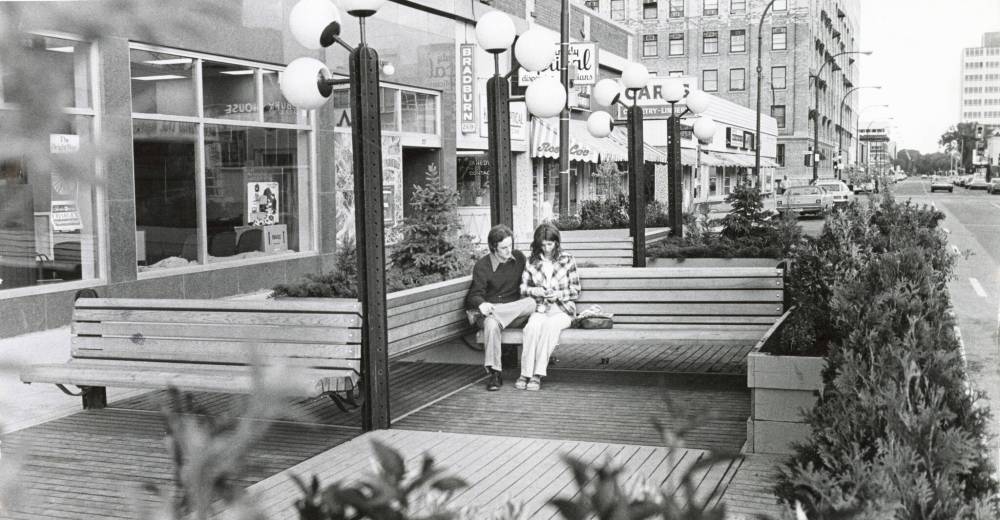Downtown’s port-a-parks of the 1970s
Advertisement
Hey there, time traveller!
This article was published 07/08/2024 (489 days ago), so information in it may no longer be current.
Winnipeg’s downtown went through a jarring transformation in the early 1970s, as entire square blocks of buildings were demolished to make way for an anticipated wave of new, large-scale urban developments outlined in Metro Winnipeg’s Downtown Development Plan of 1969.
What disappeared along with hundreds of houses, low-rise residential blocks, and small-scale commercial buildings, were the few downtown greenspaces that existed — such as the original McFadyen Park on Hargrave Street and the grounds of Alexandra School on Carlton Street.
Metro Winnipeg sought out new spaces for people to congregate which could also hide the scars of the many vacant lots until new developments materialized.

University of Manitoba Digital Collections / Jim Walker
A port-a-park On Kennedy Street at Portage Avenue on June 11, 1973.
The solution came from local architects Terry Brown and Alex Katz who proposed “port-a-parks” which were park spaces made up of interlocking modules that could be assembled, disassembled, and moved to new locations as needed.
The parks came with benches, landscaping, garbage receptacles, and lighting. Brown said that they were meant to be “a comfortable, colourful place for people to sit and watch other people”.
The first port-a-park opened in December 1971 on an empty lot at Carlton Street and Graham Avenue. In addition to the park modules, the land at the rear of the lot became a public skating rink.
The port-a-park concept received international attention when it was awarded one of seven prizes in an international urban design competition sponsored by the government of France in 1972.
The work of building the parks was then passed to the city’s environmental planning department and a duo of young designers named Ed Letisnksy and Louis Bako who were up for the task. Bako told the Winnipeg Tribune’s Marjorie Earl in July 1975 that, “… people like me and Ed are very concerned. The parks create a human environment and that’s what we want. Winnipeg is a very de-humanized city.”
Other port-a-parks opened on Kennedy Street at Portage Avenue, Main Street at McDermot Avenue, and Hargrave Street at Portage Avenue.

City of Winnipeg Archives
A port-a-park on Portage Avenue at Carlton Street, Aug. 16, 1972
The structures were praised for the most part for animating drab corners of the downtown and seemed popular among office workers at lunch time. A couple of property owners complained to city council about the one at Kennedy and Portage for taking up four on-street parking spaces and being a “hangout for hippies” in the evening.
What became of downtown’s port-a-parks? Newspaper mentions of them disappear after 1975. This was likely due to the opening of several new downtown developments, such as the Winnipeg Convention Centre, Lakeview Square, and the Centennial Library, some of which incorporated park spaces into their design.

Christian Cassidy
Christian Cassidy is a Manitoba Historical Society council member and a proud resident of the West End. He has been writing about Winnipeg history for more than a decade on his blog, West End Dumplings.
Our newsroom depends on a growing audience of readers to power our journalism. If you are not a paid reader, please consider becoming a subscriber.
Our newsroom depends on its audience of readers to power our journalism. Thank you for your support.




